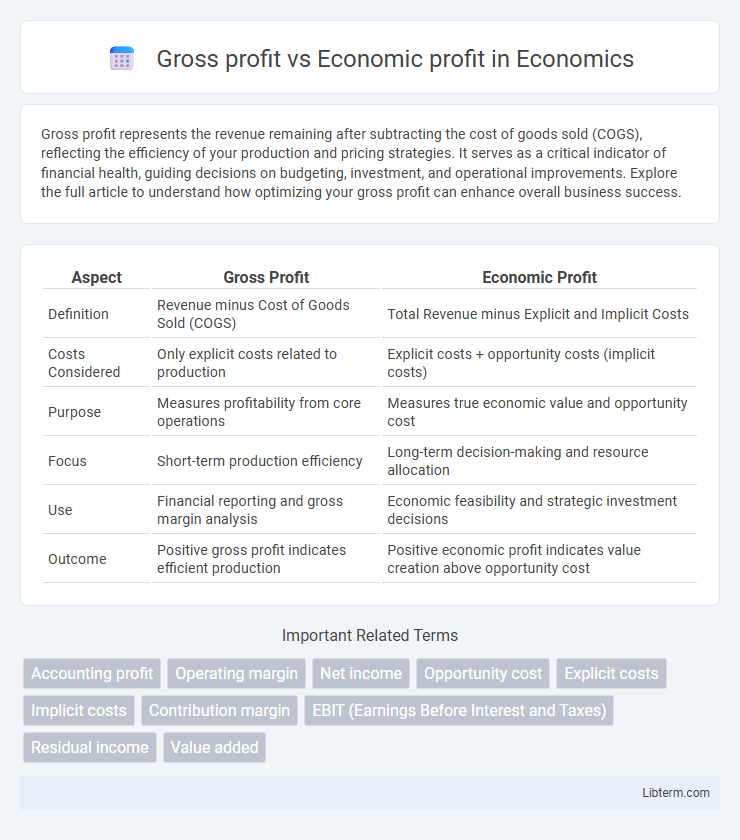Gross profit represents the revenue remaining after subtracting the cost of goods sold (COGS), reflecting the efficiency of your production and pricing strategies. It serves as a critical indicator of financial health, guiding decisions on budgeting, investment, and operational improvements. Explore the full article to understand how optimizing your gross profit can enhance overall business success.
Table of Comparison
| Aspect | Gross Profit | Economic Profit |
|---|---|---|
| Definition | Revenue minus Cost of Goods Sold (COGS) | Total Revenue minus Explicit and Implicit Costs |
| Costs Considered | Only explicit costs related to production | Explicit costs + opportunity costs (implicit costs) |
| Purpose | Measures profitability from core operations | Measures true economic value and opportunity cost |
| Focus | Short-term production efficiency | Long-term decision-making and resource allocation |
| Use | Financial reporting and gross margin analysis | Economic feasibility and strategic investment decisions |
| Outcome | Positive gross profit indicates efficient production | Positive economic profit indicates value creation above opportunity cost |
Understanding Gross Profit: Definition and Importance
Gross profit represents the revenue remaining after deducting the cost of goods sold (COGS), serving as a key indicator of a company's production efficiency and pricing strategy. This metric highlights the direct profitability of core operations, excluding other expenses like overhead, taxes, and interest, which are accounted for in economic profit. Understanding gross profit is essential for businesses to assess their financial health, optimize cost management, and strategize for sustainable growth.
What is Economic Profit? Key Concepts Explained
Economic profit measures a company's financial performance by subtracting both explicit costs and implicit costs, including opportunity costs, from total revenue. Unlike gross profit, which only accounts for direct costs of production like materials and labor, economic profit provides a deeper insight into true profitability by considering the cost of foregone alternatives. Understanding economic profit helps businesses make informed decisions about resource allocation and long-term sustainability.
Key Differences Between Gross Profit and Economic Profit
Gross profit measures a company's total revenue minus the cost of goods sold, reflecting core profitability from sales operations without accounting for other expenses. Economic profit considers both explicit and implicit costs, including opportunity costs, providing a more comprehensive view of a business's true profitability. The key difference lies in economic profit factoring in opportunity costs, whereas gross profit focuses solely on direct production costs.
Calculating Gross Profit: Step-by-Step Guide
Gross profit is calculated by subtracting the cost of goods sold (COGS) from total revenue, providing a clear measure of a company's core profitability before deducting operating expenses. To determine gross profit accurately, gather total sales revenue and COGS, including direct materials and labor costs, then perform the simple subtraction: Gross Profit = Total Revenue - COGS. This calculation highlights the financial efficiency of production and sales processes, distinct from economic profit which factors in opportunity costs and broader financial considerations.
How to Calculate Economic Profit: Formula and Examples
Economic profit is calculated by subtracting both explicit and implicit costs from total revenue, expressed as Economic Profit = Total Revenue - (Explicit Costs + Implicit Costs). Unlike gross profit, which only deducts explicit costs like production expenses, economic profit includes opportunity costs reflecting the value of foregone alternatives. For example, if a business generates $500,000 in revenue with explicit costs of $300,000 and implicit costs (opportunity costs) of $100,000, the economic profit would be $100,000.
The Role of Explicit and Implicit Costs in Profit Measurement
Gross profit measures financial gain by subtracting explicit costs, such as wages and materials, from total revenue, focusing solely on tangible expenses. Economic profit incorporates both explicit costs and implicit costs, including opportunity costs like foregone income from alternative investments or personal labor. Recognizing implicit costs provides a deeper insight into true profitability and resource allocation efficiency beyond conventional accounting.
Why Businesses Track Gross Profit and Economic Profit Separately
Businesses track gross profit to measure the efficiency of core operations by subtracting direct costs like materials and labor from total revenue, providing insight into production profitability. Economic profit accounts for both explicit and implicit costs, including opportunity costs, offering a comprehensive view of true profitability and resource allocation effectiveness. Separately analyzing these profits helps businesses optimize operational performance while evaluating strategic decision impacts on overall financial health.
Implications of Gross Profit vs Economic Profit in Decision Making
Gross profit highlights the basic profitability of a company's core operations by subtracting the cost of goods sold from total revenue, serving as a key indicator for short-term operational efficiency. Economic profit incorporates both explicit and implicit costs, including opportunity costs, providing a deeper assessment of a company's true profitability and long-term viability. Decision makers leverage economic profit to evaluate investment potential and resource allocation, while gross profit guides immediate pricing and production strategies.
Common Misconceptions About Gross and Economic Profit
Gross profit represents revenue minus the cost of goods sold, often mistaken as total profitability, while economic profit accounts for both explicit and implicit costs, including opportunity costs, providing a more comprehensive measure of true profitability. Many believe gross profit reflects overall business success, but ignoring economic profit can lead to overestimating financial health. Understanding the distinction clarifies that positive gross profit does not guarantee economic profit, especially in highly competitive markets with significant opportunity costs.
Practical Scenarios: Choosing Gross or Economic Profit for Analysis
Gross profit, calculated as revenue minus cost of goods sold, is ideal for assessing basic profitability in retail or manufacturing operations where direct costs dominate. Economic profit considers both explicit costs and implicit opportunity costs, providing a more comprehensive measure of true profitability for strategic decisions like investment evaluation or resource allocation. Businesses seeking immediate operational insights often prefer gross profit, while those conducting long-term financial analysis or comparing alternatives rely on economic profit.
Gross profit Infographic

 libterm.com
libterm.com